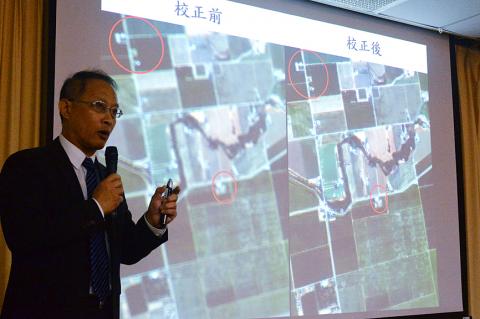Significant progress has been made in improving the imaging capabilities of Formosat-5, a National Space Organization (NSPO) official said yesterday, adding that the imagery can be used for disaster prevention.
Formosat-5, the nation’s first domestically developed satellite, was launched on Aug. 25 from Vandenberg Air Force Base in California. It was designed to deliver black-and-white images with 2m resolution and color images with 4m resolution.
While the images transmitted on Sept. 8 were blurry and tainted with light spots, NSPO officials denied there were any defects in any of the satellite’s components.

Photo: CNA
Later that month, the agency formed an advisory body of nine experts who offered advice on image adjustment and on identifying the cause of the imaging problem.
Images from Formosat-5 have achieved 5m resolution in color and 3m resolution in black and white when they are properly processed, NSPO Deputy Director-General Yu Shiann-jen (余憲政) told a news conference in Taipei.
While the images are sufficient for disaster prevention, urban planning and mapping would require greater resolution, he said.
Over the past three months, the agency has adopted three improvement measures: adjusting the temperature of the imaging facility, changing the altitude of the satellite and processing images through “deconvolution,” Yu said, adding that only the last measure worked well.
He illustrated the improvement by showing images taken by the satellite of Taipei, Nantou County, San Francisco International Airport and Davis-Monthan Air Force Base in Arizona, which were clearer than their counterparts from September.
The agency has collected more than 1,000 sets of images from the satellite, Yu said.
Davis-Monthan — best known for its so-called “boneyard” for decommissioned US government aircraft — has since the 1970s become the US military’s reference site to test aerial images, said National Chiao Tung University professor Shih Tien-yuan (史天元), a member of the advisory body.
While the root cause of the focus problem has yet to be confirmed, vibration during the satellite’s launch is one possible factor, National Central University professor Liang Chao-wen (梁肇文) said, adding that the design, composition and testing procedures of the satellite would be re-examined.
To make image processing more efficient, the agency plans to purchase new equipment with graphics processing unit systems next year, Yu said.
Asked whether the agency has a timetable for the problem to be completely fixed, Yu said it hopes to make images available to clients in August or September next year, while admitting that the time frame would be a two-month delay.

The CIA has a message for Chinese government officials worried about their place in Chinese President Xi Jinping’s (習近平) government: Come work with us. The agency released two Mandarin-language videos on social media on Thursday inviting disgruntled officials to contact the CIA. The recruitment videos posted on YouTube and X racked up more than 5 million views combined in their first day. The outreach comes as CIA Director John Ratcliffe has vowed to boost the agency’s use of intelligence from human sources and its focus on China, which has recently targeted US officials with its own espionage operations. The videos are “aimed at

STEADFAST FRIEND: The bills encourage increased Taiwan-US engagement and address China’s distortion of UN Resolution 2758 to isolate Taiwan internationally The Presidential Office yesterday thanked the US House of Representatives for unanimously passing two Taiwan-related bills highlighting its solid support for Taiwan’s democracy and global participation, and for deepening bilateral relations. One of the bills, the Taiwan Assurance Implementation Act, requires the US Department of State to periodically review its guidelines for engagement with Taiwan, and report to the US Congress on the guidelines and plans to lift self-imposed limitations on US-Taiwan engagement. The other bill is the Taiwan International Solidarity Act, which clarifies that UN Resolution 2758 does not address the issue of the representation of Taiwan or its people in

US Indo-Pacific Commander Admiral Samuel Paparo on Friday expressed concern over the rate at which China is diversifying its military exercises, the Financial Times (FT) reported on Saturday. “The rates of change on the depth and breadth of their exercises is the one non-linear effect that I’ve seen in the last year that wakes me up at night or keeps me up at night,” Paparo was quoted by FT as saying while attending the annual Sedona Forum at the McCain Institute in Arizona. Paparo also expressed concern over the speed with which China was expanding its military. While the US

SHIFT: Taiwan’s better-than-expected first-quarter GDP and signs of weakness in the US have driven global capital back to emerging markets, the central bank head said The central bank yesterday blamed market speculation for the steep rise in the local currency, and urged exporters and financial institutions to stay calm and stop panic sell-offs to avoid hurting their own profitability. The nation’s top monetary policymaker said that it would step in, if necessary, to maintain order and stability in the foreign exchange market. The remarks came as the NT dollar yesterday closed up NT$0.919 to NT$30.145 against the US dollar in Taipei trading, after rising as high as NT$29.59 in intraday trading. The local currency has surged 5.85 percent against the greenback over the past two sessions, central